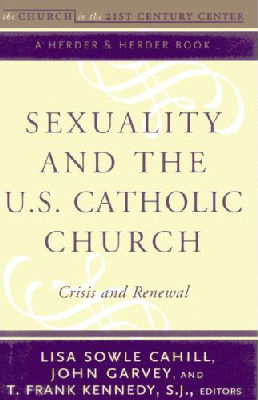
|
Posted February 6, 2007
Book: Sexuality and the U.S. Catholic Church: Crisis and Renewal Editors: Lisa Sowle Cahill, John Gravey, and T. Frank Kennedy, S.J. A Herder and Herder Book. New York. 2006. Pp. 233 An Excerpt from the Jacket:
Major topics include: Homosexuality Marriage and the nuptial meaning of the body The theology of the body: possibilities and limitations Views of celibacy past and present Rebuilding Community Childbearing Sexual discipleship Future challenges An Excerpt from the Book: Committed lifelong celibacy has always been only an alternative way — an alternative to marriage and to life in a family, and also an alternative to singleness without a focused permanent commitment to celibacy. As such, it has offered a way of relating to God and to neighbor that is of value in itself, but also revelatory of the meaning of sexuality for the Christian community and the wider society beyond. Whatever the aberrations in some past historical settings, celebacy has always held the potential of challenging existing power relations, liberating individuals for the unexpected, breaking the bonds of gender stereotyhpes, and resisting the social construction of sexual meanings in any era. There is no reason to prevent the option of religiously motivated lifelong celibacy from fulfilling these functions today. The twenty-first century brings its own sexual problematic, and it is one for which celibacy is not irrelevant. The work of the French philosopher Michel Foucault was preoccupied with a question that his massive history of human sexuality was not finally able to answer: how did contemporary Western culture come to believe that sexuality is the key to individual identity? How did sex become more important than love, and almost more important than life? Celibates have no more of an answer to that question than anyone else. But the option of celibacy keeps such a question in perspective and perhaps even alive. Celibacy represents the possibility that genital sex need not be at the heart of every profound human relationship, and that sexual intensity, lived celibately, can empower the human person as a whole. Perhaps particularly for women in the twenty-first century, committed lifelong celibacy holds the possibility of resisting and transcending gender stereotypes that continuously threaten to limit the spheres within which women (and men, for that matter) may live and work. In an era when the importance of gender is more and more questioned — whether in marriage, partnerships of all kinds or roles in the family, church, and society — celibate individuals and groups provide perspectives and insights of critical importance to all. Genital sexual renunciation need not (ought not, and probably cannot) render individuals sexless or gender-free, but it can expand the horizons against which gender and sex gain meaning. Moreover, in a time when population growth is less of a problem than ever before (when, in terms used by Peter Brown, there is no need to “replace the dead”) celibates can help to make visible the multiple forms of fruitfulness that characterize human relationships and endeavors. Table of Contents: 1. Rebuilding community: credibility, sensitivity, and hope 2. Heaven is a place on earth? Analyzing the popularity of Pope John Paul II’s theology of body 3. “When they rise from the dead, they neither marry nor are given in marriage”: Marriage and sexuality, eschatology, and the nuptial meaning of the body in Pope John Paul II’s Theology of the Body 4. Being in love and begetting a child: a Greek myth of Eros and the Christian mystery of marriage 5. Under pressure: sexual discipleship in the real world 6. Celibacy: decisive moments in its history 7. The perils of celibacy: clerical celibacy and marriage in the Protestant Reformation 8. Monastic perspectives on celibacy 9. Celibacy under the sign of the cross 10. Homosexuality and the Church 11. Following the still small voice: experience, truth, and argument as lived by Catholics around the gay issue 12. Descriptions and prescriptions: proposed remedies for a Church in crisis |
|
